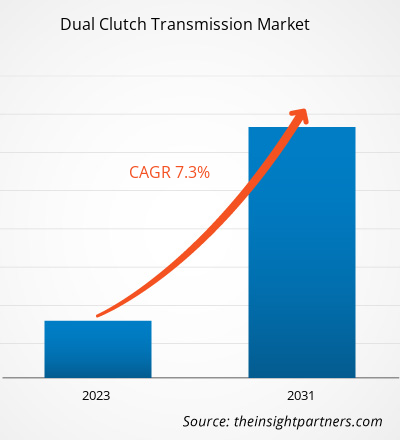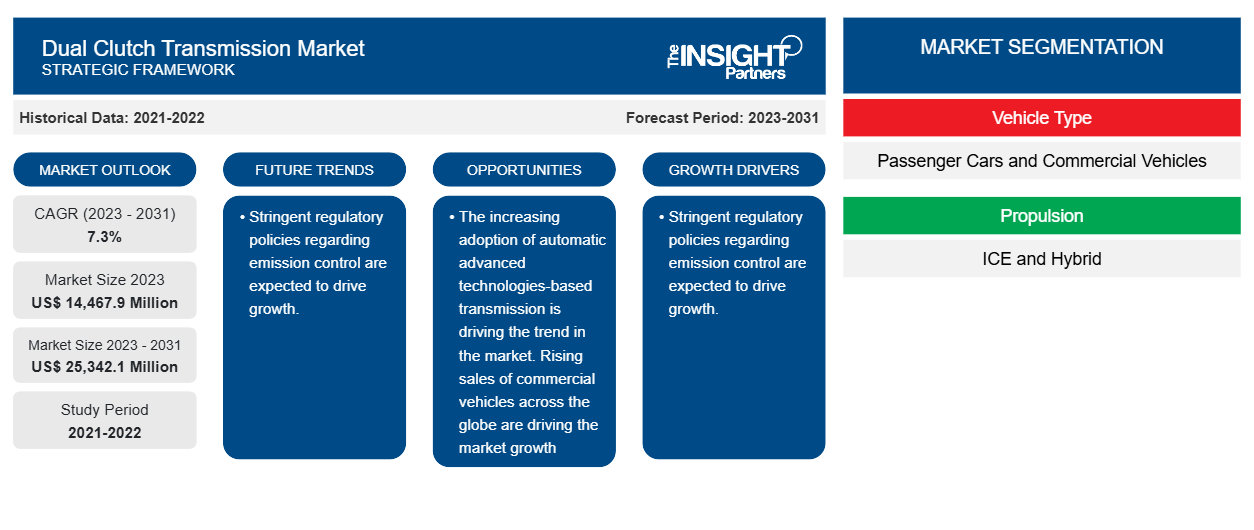Si prevede che la dimensione del mercato della trasmissione a doppia frizione raggiungerà i 25.342,1 milioni di dollari entro il 2031, rispetto ai 14.467,9 milioni di dollari del 2023. Si prevede che il mercato registrerà un CAGR del 7,3% nel periodo 2023-2031. La crescente adozione di trasmissioni automatiche basate su tecnologie avanzate sta guidando la tendenza del mercato. Le crescenti vendite di veicoli commerciali in tutto il mondo stanno guidando la crescita del mercato.
Analisi di mercato della trasmissione a doppia frizione
Il mercato della trasmissione a doppia frizione ( DCT ) è guidato principalmente dall'aumento delle vendite di veicoli commerciali e passeggeri in tutto il mondo. La domanda di trasmissione a doppia frizione ha la quota maggiore nella regione Asia-Pacifico a causa dell'aumento delle vendite di veicoli in India, Cina e Giappone. Nei veicoli passeggeri e commerciali, la trasmissione a doppia frizione utilizza una frizione automatica per migliorare l'efficienza del carburante e offrire elevate prestazioni dei veicoli. La trasmissione a doppia frizione utilizza due dischi della frizione che consentono un rapido cambio di marcia senza alcun ritardo di input.
Panoramica del mercato della trasmissione a doppia frizione
Una trasmissione a doppia frizione ( DCT ) è una trasmissione manuale automatizzata nei veicoli commerciali e per passeggeri . Questo sistema di trasmissione utilizza due frizioni per impostare set di ingranaggi dispari e pari. La tecnologia di trasmissione a doppia frizione offre due trasmissioni manuali. Un percorso fornisce prima, terza, quinta ed eventualmente settima marcia per cambiare automaticamente, mentre l'altro fornisce rapporti di trasmissione pari e trasmissione in retromarcia. Con una domanda crescente di miglioramento dell'efficienza del carburante e delle prestazioni del veicolo, viene utilizzata la tecnologia di trasmissione a doppia frizione. La tecnologia di trasmissione a doppia frizione offre un cambio marcia senza interruzioni e un'efficiente distribuzione della potenza per veicoli commerciali e per passeggeri.
Personalizza questo report in base alle tue esigenze
Riceverai la personalizzazione gratuita di qualsiasi report, comprese parti di questo report, o analisi a livello nazionale, pacchetto dati Excel, oltre a usufruire di grandi offerte e sconti per start-up e università
-
Scopri le principali tendenze di mercato in questo rapporto.Questo campione GRATUITO includerà analisi di dati che spaziano dalle tendenze di mercato alle stime e alle previsioni.
Driver e opportunità del mercato della trasmissione a doppia frizione
Si prevede che le severe politiche normative in materia di controllo delle emissioni stimoleranno la crescita.
In Nord America, si prevede che iniziative del governo, politiche federali e programmi per vari settori guideranno il mercato degli autobus elettrici. Stati Uniti, Canada e Messico hanno firmato l'accordo commerciale NAFTA. L'accordo commerciale ha aiutato le case automobilistiche con l'aumento del numero di stabilimenti di produzione e una migliore catena di fornitura di ricambi auto. Il governo del Messico è fortemente concentrato sull'attrazione di IDE per potenziare il settore manifatturiero del paese. Case automobilistiche come BMW, Audi e Mercedes stanno investendo nel paese. Ciò è dovuto ai vari vantaggi fiscali e alle importazioni esenti da dazi offerti dal governo del Messico. Inoltre, diversi altri produttori di automobili hanno una base esistente nel paese.
I governi di vari paesi della regione APAC si stanno concentrando sulla produzione di automobili e sul rispettivo paese stesso. Ad esempio, attraverso Made in China nel 2025, il governo cinese sta supportando le aziende locali per competere con le case automobilistiche straniere e per competere a livello globale. Inoltre, le iniziative del governo indiano, come l'Automotive Mission Plan 2016-26, forniscono supporto governativo alla crescente industria manifatturiera automobilistica del paese. Pertanto, queste iniziative governative sosterrebbero la crescita del settore automobilistico nella regione, che sosterrà la crescita del mercato della trasmissione a doppia frizione in APAC .
Si prevede che la crescente adozione di sistemi di frizione basati su tecnologie avanzate stimolerà la crescita del mercato
I principali attori del mercato stanno adottando sistemi di trasmissione basati su tecnologie avanzate per lanciare nuovi modelli di veicoli. Ad esempio, nell'aprile 2024, Stellantis N.V. ha lanciato un sistema di trasmissione a doppia frizione elettrificato in Italia. La società ha pianificato un investimento di circa 260 milioni di dollari USA per l'istituzione dell'industria automobilistica italiana nel Mirafiori Automotive Park. Stellantis N.V. ha anche annunciato altri 108 milioni di dollari USA per aumentare il potenziale della Fiat 500e. Si prevede che un tale aumento dell'investimento e del lancio dello sviluppo dei nuovi sistemi DCT da parte dei principali attori creerà ampie opportunità di crescita del mercato.
Analisi della segmentazione del rapporto di mercato sulla trasmissione a doppia frizione
I segmenti chiave che hanno contribuito alla derivazione dell'analisi di mercato della trasmissione a doppia frizione sono il tipo di veicolo, la propulsione, la classe del veicolo e l'area geografica.
- In base al tipo di veicolo, il mercato è suddiviso in autovetture e veicoli commerciali. Tra questi, le autovetture hanno avuto la quota maggiore nel 2023. Ciò è dovuto alla crescente vendita di autovetture in tutto il mondo.
- A seconda della propulsione, il mercato è diviso in ICE e ibrido. Tra questi, ICE ha avuto la quota maggiore nel 2023. Ciò è dovuto all'aumento delle vendite di veicoli in tutto il mondo. Secondo l'Agenzia Internazionale per l'Energia, le vendite globali di automobili sono aumentate a 92,72 milioni di unità nel 2022, rispetto alle 82,8 milioni di unità del 2021.
- A seconda della classe del veicolo, il mercato è diviso in A/B, C, D, E e superiori, e SUV e marce avanti (6, 7 e 8 e superiori). Tra queste, SUV ha la quota maggiore a causa della crescente adozione di DCT nelle auto SUV.
Analisi della quota di mercato della trasmissione a doppia frizione per area geografica
L'ambito geografico del rapporto sul mercato delle trasmissioni a doppia frizione è suddiviso principalmente in cinque regioni: Nord America, Asia Pacifico, Europa, Medio Oriente e Africa, e Sud e Centro America.
Si prevede che l'Asia Pacifica avrà la quota maggiore nel mercato delle trasmissioni a doppia frizione a causa dell'aumento della domanda e della vendita di automobili nei paesi in via di sviluppo come Cina, India e Giappone. Nel 2023, secondo la China Automotive Manufacturers Association, circa 26 milioni di unità di autovetture sono state vendute in Cina. L'India è stata il secondo mercato più grande nella regione Asia Pacifica. Questi fattori sono responsabili della crescita del mercato delle trasmissioni a doppia frizione durante il periodo di previsione.
Approfondimenti regionali sul mercato della trasmissione a doppia frizione
Le tendenze regionali e i fattori che influenzano il mercato delle trasmissioni a doppia frizione durante il periodo di previsione sono stati ampiamente spiegati dagli analisti di Insight Partners. Questa sezione discute anche i segmenti e la geografia del mercato delle trasmissioni a doppia frizione in Nord America, Europa, Asia Pacifico, Medio Oriente e Africa e America meridionale e centrale.

- Ottieni i dati specifici regionali per il mercato della trasmissione a doppia frizione
Ambito del rapporto di mercato sulla trasmissione a doppia frizione
| Attributo del report | Dettagli |
|---|---|
| Dimensioni del mercato nel 2023 | 14.467,9 milioni di dollari USA |
| Dimensioni del mercato entro il 2031 | 25.342,1 milioni di dollari USA |
| CAGR globale (2023-2031) | 7,3% |
| Dati storici | 2021-2022 |
| Periodo di previsione | 2023-2031 |
| Segmenti coperti |
Per tipo di veicolo
|
| Regioni e Paesi coperti |
America del Nord
|
| Leader di mercato e profili aziendali chiave |
|
Densità degli attori del mercato: comprendere il suo impatto sulle dinamiche aziendali
Il mercato del mercato delle trasmissioni a doppia frizione sta crescendo rapidamente, spinto dalla crescente domanda degli utenti finali dovuta a fattori quali l'evoluzione delle preferenze dei consumatori, i progressi tecnologici e una maggiore consapevolezza dei vantaggi del prodotto. Con l'aumento della domanda, le aziende stanno ampliando le loro offerte, innovando per soddisfare le esigenze dei consumatori e capitalizzando sulle tendenze emergenti, il che alimenta ulteriormente la crescita del mercato.
La densità degli operatori di mercato si riferisce alla distribuzione di aziende o società che operano in un particolare mercato o settore. Indica quanti concorrenti (operatori di mercato) sono presenti in un dato spazio di mercato in relazione alle sue dimensioni o al valore di mercato totale.
Le principali aziende che operano nel mercato della trasmissione a doppia frizione sono:
- Magna International Inc.
- Schaeffler Technologies AG & Co. KG
- Società anonima BorgWarner Inc.
- Società Agricola Daimler
- Volkswagen AG
- ZF Friedrichshafen AG
Disclaimer : le aziende elencate sopra non sono classificate secondo un ordine particolare.

- Ottieni una panoramica dei principali attori del mercato della trasmissione a doppia frizione
Notizie di mercato e sviluppi recenti sulla trasmissione a doppia frizione
Il mercato delle trasmissioni a doppia frizione viene valutato raccogliendo dati qualitativi e quantitativi dopo la ricerca primaria e secondaria, che include importanti pubblicazioni aziendali, dati associativi e database. Di seguito sono elencati alcuni degli sviluppi nel mercato delle trasmissioni a doppia frizione:
- Punch Powertrain lancia il suo innovativo sistema DCT con un design rivoluzionario, più compatto e conveniente. Il DT1 è stato lanciato in India, debuttando nel recente lancio di Altroz DCA da parte di Tata Motors. (Fonte: sito Web aziendale, marzo 2022)
- Tata AutoComp investirà 500 crore di rupie nello stabilimento di trasmissione a doppia frizione di Chakan. Con l'obiettivo di soddisfare la crescente domanda di auto dotate di trasmissione automatica in India, Tata AutoComp punta a un vantaggio da first mover mentre prepara un nuovo stabilimento con una capacità produttiva iniziale di 100.000 unità. (Fonte: comunicato stampa, gennaio 2023)
Copertura e risultati del rapporto sul mercato della trasmissione a doppia frizione
Il rapporto "Dimensioni e previsioni del mercato della trasmissione a doppia frizione (2021-2031)" fornisce un'analisi dettagliata del mercato che copre le seguenti aree:
- Dimensioni e previsioni del mercato della trasmissione a doppia frizione a livello globale, regionale e nazionale per tutti i segmenti di mercato chiave coperti dall'ambito
- Tendenze del mercato della trasmissione a doppia frizione e dinamiche di mercato come conducenti, restrizioni e opportunità chiave
- Analisi PEST e SWOT dettagliate
- Analisi di mercato della trasmissione a doppia frizione che copre le principali tendenze del mercato, il quadro globale e regionale, i principali attori, le normative e i recenti sviluppi del mercato
- Analisi del panorama industriale e della concorrenza che copre la concentrazione del mercato, l'analisi della mappa di calore, i principali attori e gli sviluppi recenti per il mercato della trasmissione a doppia frizione
- Profili aziendali dettagliati
- Analisi storica (2 anni), anno base, previsione (7 anni) con CAGR
- Analisi PEST e SWOT
- Valore/volume delle dimensioni del mercato - Globale, Regionale, Nazionale
- Industria e panorama competitivo
- Set di dati Excel
Report recenti
Testimonianze
Motivo dell'acquisto
- Processo decisionale informato
- Comprensione delle dinamiche di mercato
- Analisi competitiva
- Analisi dei clienti
- Previsioni di mercato
- Mitigazione del rischio
- Pianificazione strategica
- Giustificazione degli investimenti
- Identificazione dei mercati emergenti
- Miglioramento delle strategie di marketing
- Aumento dell'efficienza operativa
- Allineamento alle tendenze normative























 Ottieni un campione gratuito per - Mercato della trasmissione a doppia frizione
Ottieni un campione gratuito per - Mercato della trasmissione a doppia frizione